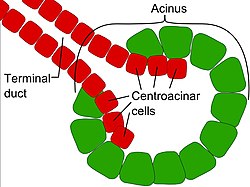Exocrine glandsareglandsthat secrete substances onto anepithelialsurface by way of aduct.[1]Examples of exocrine glands includesweat,salivary,mammary,ceruminous,lacrimal,sebaceous,prostateandmucous.Exocrine glands are one of two types of glands in the human body, the other beingendocrine glands,which secrete their products directly into thebloodstream.Theliverandpancreasare both exocrine and endocrine glands; they are exocrine glands because they secrete products—bileandpancreatic juice—into thegastrointestinal tractthrough a series of ducts, and endocrine because they secrete other substances directly into the bloodstream. Exocrine sweat glands are part of the integumentary system; they have eccrine and apocrine types.
| Exocrine gland | |
|---|---|
 | |
| Details | |
| Identifiers | |
| Latin | glandula exocrina |
| MeSH | D005088 |
| TH | H2.00.02.0.03014 |
| FMA | 9596 |
| Anatomical terminology | |
Classification
editStructure
editExocrine glands contain a glandular portion and a duct portion, the structures of which can be used to classify the gland.[1]
- The duct portion may be branched (called compound) or unbranched (called simple).
- The glandular portion may betubularoracinar,or may be a mix of the two (called tubuloacinar). If the glandular portion branches, then the gland is called a branched gland.
Method of secretion
editDepending on how their products are secreted, exocrine glands are categorized asmerocrine,apocrine,orholocrine.[1]
- Merocrine– the cells of the gland excrete their substances byexocytosisinto a duct; for example, pancreatic acinar cells,eccrine sweat glands[dubious–discuss],salivary glands,goblet cells,intestinal glands,tear glands,etc.
- Apocrine– the apical portion of thecytoplasmin thecell membrane,which contains the excretion,buds off.Examples are sweat glands of arm pits, pubic region, skin around anus, lips and nipples;mammary glands,etc.
- Holocrine– the entire cell disintegrates to excrete its substance; for example, sebaceous glands of theskinand nose,meibomian gland,zeis gland,etc.
-
Merocrine secretion
-
Apocrine secretion
-
Holocrine secretion
Product secreted
edit- Serous cellssecreteproteins,oftenenzymes.Examples includegastric chief cellsandPaneth cells
- Mucous cellssecretemucus.Examples includeBrunner's glands,esophageal glands,andpyloric glands
- Seromucous glands (mixed) secrete both protein and mucus. Examples include thesalivary glands:although theparotid gland(saliva secretion 25%) is predominantly serous, thesublingual gland(saliva secretion 5%) mainly mucous gland, and thesubmandibular gland(saliva secretion 70%) is a mixed, mainly serous gland.
- Sebaceous glandssecretesebum,a lipid product. These glands are also known as oil glands, e.g.Fordyce spotsandMeibomian glands.
Additional images
edit-
Section of the humanesophagus.
-
Dissection of a lactating breast.
See also
editReferences
edit- ^abcYoung, Barbara; O'Dowd, Geraldine; Woodford, Phillip (2013).Wheater's Functional Histology: A Text and Colour Atlas(Sixth ed.). Elsevier. p. 95.ISBN978-0702047473.LCCN2013036824.